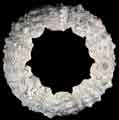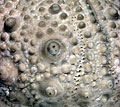The Echinoid Directory
Asterocidaris sp.
| Diagnostic Features |
|
|---|---|
| Distribution | Middle to Upper Jurassic (Bajocian-Oxfordian), Europe. |
| Type | |
| Species Included | |
| Classification and/or Status |
|
| Remarks |




